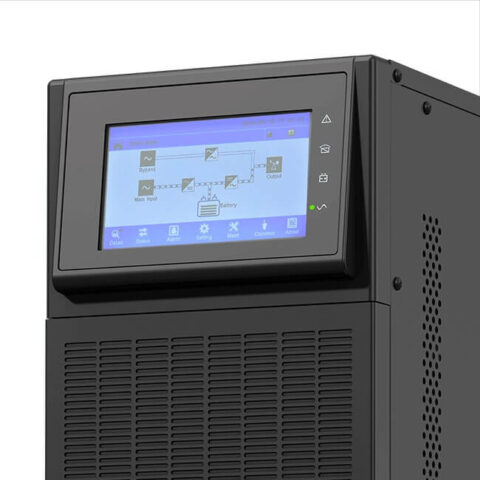Summary
N+1 redundancy in a UPS system means there is one extra power module beyond what’s needed to support the full load. If one module fails, the system still delivers uninterrupted power. 2N redundancy duplicates the entire system for full failover. Modular designs allow scalable, hot-swappable redundancy, essential for hospitals, data centres, and critical infrastructure.
Introduction
When you’re writing tender specifications for critical infrastructure (a hospital ICU, regional data centre, or transport signalling hub), redundancy is a compliance matter, a duty-of-care requirement, and a business continuity safeguard. In UPS architecture, redundancy refers to the deliberate inclusion of extra power capacity to ensure continuous operation even when part of the system fails.
PSS Distributors works closely with engineers and procurement teams to help them specify the right redundancy model (not just the most expensive one) based on risk class, load criticality, and service availability requirements. This guide breaks down the different redundancy strategies, from N+1 to 2N and modular parallel systems, so your UPS specification delivers on uptime, compliance and value.
What Is UPS Redundancy?
When we talk about redundancy in uninterruptible power supply systems, we’re not simply referring to backup power but to operational assurance. Redundancy is about keeping your systems online even when a UPS module fails or is taken offline for maintenance. It’s a design principle that enables fault tolerance at the electrical level, and in regulated sectors, it’s often a mandated requirement.
Why Is UPS Redundancy Important?
For healthcare tenders, particularly where theatre lighting, life support or ICU load is involved, minimum uptime thresholds are non-negotiable. In public safety applications like police communications, ambulance dispatch or critical CCTV feeds, a single point of failure could mean reputational damage or worse, compromised response.
This is why redundancy isn’t a budget line item. It’s a compliance measure. In our work at PSS Distributors, we’ve seen tender submissions fail simply because the proposed UPS solution couldn’t demonstrate redundancy alignment with the application’s risk class.
What’s important to remember is that more redundancy isn’t always better. We regularly advise consultants who’ve specified 2N or N+2 topologies where a well-engineered N+1 would have been sufficient, and much more cost-effective. Misaligned redundancy not only adds cost, but it also increases system complexity and servicing overheads.
As a general rule:
- Low to medium risk environments (e.g. council depots, IT closets) may not require formal redundancy.
- Critical sites (e.g. hospitals, data centres, air traffic control) often demand documented N+1 or 2N protection.
- Modular systems can provide redundancy with scalability, reducing upfront investment.
If you’re in the process of defining your site’s UPS redundancy strategy, we assist engineering teams every week with load class analysis and specification validation.
Unsure which redundancy model your site requires? Submit your tender spec for review.
3 Types of UPS Redundancy
1) What Is N+1 Redundancy in UPS Architecture?
N+1 redundancy is a fault-tolerant UPS architecture that includes the exact number of power modules needed to support your full critical load (N), plus one additional module (+1). If one unit fails or is taken offline, the remaining modules continue supplying uninterrupted power.
How It Works
- Required UPS capacity = “N”
- One extra module added = “+1”
- If any one module fails, system still operates at full capacity
For example, if a site needs 3 modules to handle the load, an N+1 setup will include 4 modules, ensuring continuity without the need for failover switching.
Where to Use N+1 Redundancy
This configuration strikes the right balance between uptime and cost, especially when combined with modular UPS systems. It’s commonly specified in:
- Hospitals (non-ICU wards, imaging suites)
- Tier II data centres
- Public safety command rooms
- Transport control networks
- Broadcast and telecommunications sites
PSS Products That Support N+1 Redundancy
- 3/1 Phase Modular UPS (3kVA–6kVA hot-swappable modules)
- 3/3 Phase Modular UPS (20kVA–40kVA modules, scalable to 520kVA/rack)
- Epower UPS (10kVA–200kVA modules)Epower is not modular
- PMU-T in Parrallel configuration
- PMU+ is modular
These units feature plug-and-play modules, decentralised parallel structure, and common battery architecture, ideal for service continuity without overspending.
Benefits of N+1 Redundancy
- Maintains full load during one module failure
- Avoids full system duplication
- Faster ROI compared to 2N
- Ideal for modular growth strategies
Example clause: “UPS system must feature modular N+1 redundancy, with sufficient capacity to sustain full critical load during module failure or maintenance.”
2) What Is 2N Redundancy in UPS Architecture?
2N redundancy refers to two completely independent UPS systems, each fully capable of supporting the entire load. One is active; the other is ready to take over with no interruption if the first fails.
How It Works
- One UPS system supports full load
- Second UPS mirrors the first with identical capacity
- If UPS-A fails, UPS-B seamlessly takes over
There’s no single point of failure: batteries, inverters, or even monitoring systems.
Where to Use 2N Redundancy
The 2N configuration is used in zero-downtime environments where even a single UPS module failure is unacceptable:
- Tier III & IV data centres
- Defence and military operations
- Mission-critical healthcare (ICUs, theatres)
- Banking platforms and national payment infrastructure
PSS Products That Support 2N Redundancy
- 3/3 Phase Modular UPS (Easily mirrored in 2N pairs)
Each system can be installed in its own rack, with separate battery banks and full decentralised operation.
Benefits of 2N Redundancy
- Full system redundancy
- No service interruption during component failure or maintenance
- Maximum fault tolerance and risk mitigation
- Independent operation (dual inverters, batteries, controls)
Example clause: “UPS configuration must support 2N redundancy: two independent, mirrored systems capable of sustaining 100% load in the event of full system failure.”
3) What Is Modular Redundancy in UPS Architecture?
Modular redundancy refers to a UPS design where capacity and redundancy are built using interchangeable modules housed within a central chassis. Each module operates independently and contributes to the total system load.
How It Works
- UPS capacity built using multiple swappable modules
- Redundancy achieved by adding extra modules (e.g. N+1)
- Modules communicate via decentralised control
When one module fails, it can be removed and replaced while the rest of the system stays online.
Where to Use Modular Redundancy
Modular UPS systems are ideal when projects demand:
- Scalability over time
- Minimal mean time to repair (MTTR)
- Field-replaceable maintenance
- Future-proof design with capacity expansion
We see modular UPS frequently specified in:
- Government IT rooms
- Council depots
- Mines and industrial automation sites
- Transport hubs and network switching locations
PSS Modular UPS Range
Both models support up to 10 modules per rack, with high power density (520kVA max), plug-and-play servicing, and touch-screen LCD diagnostics.
Benefits of Modular Redundancy
- Hot-swappable architecture
- Scale from 20kVA to 520kVA
- Centralised battery bank
- Reduced footprint, simplified maintenance
- Faster procurement and installation
Example clause: “UPS system must utilise a modular, hot-swappable design with support for N+1 redundancy and decentralised control.”
When Should You Specify Redundancy in Tenders?
Not every project needs full system redundancy, but the ones that do, really do. The right level of UPS redundancy in your specification depends on your site’s risk profile, regulatory requirements, and downtime tolerance.
Redundancy ensures that even if part of your UPS fails, critical operations continue uninterrupted. But redundancy should be intentional, not automatic. Overspecifying increases capital and operating costs. Underspecifying exposes your site to reputational and operational risk.
How to Decide on Redundancy Level
| Site Type | Recommended Redundancy | Typical Runtime Requirement |
| Hospital ICU / Surgical Suite | N+1 or 2N | 15–30 minutes minimum |
| Small Data Centre / Server Room | N+1 (scalable to 2N if Tier III) | 10–20 minutes, depending on load |
| Council CCTV Node / Roller Shutter | No redundancy (single path UPS) | 5–10 minutes |
| Transport Switching Station | N+1 | 15–30 minutes |
| Mining Operations | Modular N+1 recommended | Varies – consider runtime and load |
If your project has uninterruptible load requirements like real-time control systems or patient life support, the expectation will be N+1 at a minimum, often 2N. But for auxiliary or peripheral systems, single-path UPS may be sufficient.
Use Redundancy Only Where Justified
Tender reviewers increasingly want to see risk-based design, not templated overengineering. Including N+1 or 2N must be defensible. Consider:
- Criticality of the protected load
- Environmental constraints (e.g. remote access, serviceability)
- Expected SLA for restoration time
- Lifecycle operating budget
Redundancy is about availability. Runtime is about autonomy. You can have one without the other, but most mission-critical environments require both.
Note: Redundancy ≠ runtime
→ Runtime = how long your load stays up during an outage
→ Redundancy = whether a single fault will take your load offline
Have you considered runtime and redundancy? Download our UPS Tender Cheat Sheet.
Common Tender Mistakes When Specifying Redundancy
In procurement reviews, I’ve seen well-intentioned UPS specs lose marks (or worse, misalign with the site’s true operational needs0 because redundancy was misunderstood or misapplied. Redundancy is a technical safeguard, but it must be strategically specified.
1) Writing “2N Preferred” Without Dual Supply Infrastructure
If your site doesn’t have dual incoming mains feeds, physical separation between A/B systems, or load-transfer architecture, specifying 2N is misleading. Redundancy at this level is only viable when power and distribution infrastructure are designed to support it.
What to specify instead: “UPS configuration must provide N+1 redundancy. 2N configuration acceptable where dual utility or generator feeds exist.”
2) Confusing Modular UPS With Modular Redundancy
Many tenders use “modular” and “redundant” interchangeably. They’re not the same. A modular UPS supports scalability and hot-swappable components. Redundancy comes from configuring extra capacity (e.g. 3 x 10kVA modules for a 20kVA load = N+1).
What to specify instead: “UPS must use modular architecture and provide N+1 redundancy within rack configuration.”
3) Failing to Match Redundancy to Load Type
Not all loads warrant redundancy. Surveillance systems, access control, and non-critical lighting can often tolerate short interruptions. But hospital equipment, financial systems, and core networking do not.
Over-specifying redundancy for every subsystem increases cost without benefit.
What to specify instead: “Critical loads must be supported by UPS with N+1 or greater redundancy. Peripheral systems may use single-path UPS without redundancy.”
4) Ignoring Space and Electrical Provisioning for Growth
Some specs call for scalable redundancy (e.g. “system must be expandable to 40kVA”) but forget to allocate the physical rack space, power, or cooling envelope required for future modules.
What to specify instead: “UPS must allow capacity expansion to 40kVA within existing cabinet. Tendering party must confirm space, heat dissipation, and circuit allowance.”
Want to avoid these and other common spec issues? Download: Top 10 Mistakes in UPS Tender Specs.
UPS Redundancy and Tender Compliance in Australia
When specifying uninterruptible power systems for Australian tenders, aligning with statutory and industry-specific expectations is non-negotiable. Over the years, I’ve worked closely with procurement leads across health, transport, defence, and utilities. And one thing is clear: UPS redundancy isn’t a preference; it’s often a compliance requirement.
Redundancy Requirements in Healthcare Tenders
In hospital and healthcare facility tenders, N+1 redundancy is frequently mandatory. This is especially true for:
- Intensive care and surgical suites
- Medical imaging rooms
- Critical life support systems
- Nurse call and communication infrastructure
In addition, most specs stipulate hot-swappable battery modules and no single point of failure across power continuity systems.
Example clause: “UPS shall provide N+1 modular redundancy. Battery modules must be hot-swappable and accessible from the front panel. System must support fault-tolerant operation.”
Government and Infrastructure Compliance
For government-run infrastructure, particularly data centres, rail signalling, or utilities, redundancy clauses often reference international and local standards. Among the most commonly cited:
- AS/NZS 62040 series (particularly Part 3)
- Uptime Institute Tier compliance for redundancy and fault tolerance
- ISO 22301 (Business Continuity) where applicable
Specs frequently seek modular, decentralised UPS configurations to facilitate rapid service and reduced MTTR (Mean Time to Repair).
PSS has supplied fully compliant N+1 and 2N modular UPS systems across multiple state and federal projects, including health precincts, smart city networks, and transport hubs.
Our Tender Documentation Advantage
Apart from providing UPS hardware, we also supply the technical artefacts required for compliance sign-off:
- Product datasheets with test ratings (e.g. MTBF, THDi, PF)
- Redundancy configuration diagrams
- Warranty and support SLAs
- Site planning tools and load calculators
This ensures procurement officers and consulting engineers have the right language and documentation to justify the selection.
Need tender-ready specs for your UPS solution? Submit your documentation requirements.
UPS Redundancy FAQs
What is N+1 redundancy in a UPS system?
N+1 redundancy means the UPS system includes one more power module than is required to support the full load. If your load requires 40kVA, the system will include 40kVA of capacity plus one additional module (e.g. 20kVA), ensuring uninterrupted operation even if one module fails. It’s a cost-effective way to build resilience without doubling infrastructure.
Example clause: “UPS must support N+1 redundancy with autonomous modules capable of maintaining full load upon single module failure.”
Is 2N UPS redundancy always required in tenders?
No. 2N is rarely mandatory but often preferred in the most critical environments, such as Tier IV data centres, defence infrastructure, or life-support-intensive hospital zones. 2N systems use two completely independent UPS paths, each capable of supporting the entire load. Most government and commercial tenders favour N+1 unless there’s zero tolerance for risk.
What’s the difference between modular and N+1 redundancy?
N+1 describes the redundancy model: having one more module than needed for the load.
Modular refers to how the system is built: smaller swappable units that slot into a rack, offering scalability, hot-swap maintenance, and decentralised fault handling.
Many modular systems support N+1 or even 2N+1 configurations, but not all N+1 systems are modular.
Final Considerations for UPS Architecture Redundancy
When we review UPS tenders at PSS Distributors, one pattern is clear: redundancy often gets overlooked until something goes wrong. N+1, 2N, and modular UPS configurations are decisions that determine whether essential services stay online during a crisis or stall in the dark.
If your facility handles healthcare, transport, data infrastructure, or public safety, redundancy is not optional. But neither is over-specifying and blowing out the budget. That’s where understanding the nuances of N+1, 2N, and modular design can give you an edge, not just in performance, but in procurement credibility.
Let us help you get the spec right the first time. Our technical team reviews tenders daily and can help you avoid the usual traps: ambiguous uptime targets, unscalable systems, vague phrasing. We are fluent in both engineering and compliance, and we’re here to help.
Resources
Download the UPS Tender Cheat Sheet →
A quick-reference guide to spec writing, sizing, redundancy planning, and technology comparisons.
Submit Your Tender Spec for Review →
Upload your current draft and we’ll give you feedback on runtime sizing, redundancy, topology, and compliance fit.
Download UPS Specification Template →
An editable document you can use to write more accurate, review-ready tender specifications.
Explore Modular and Epower UPS Products →
Browse our N+X modular UPS solutions: scalable, hot-swappable (Modular), and engineered for mission-critical uptime.




